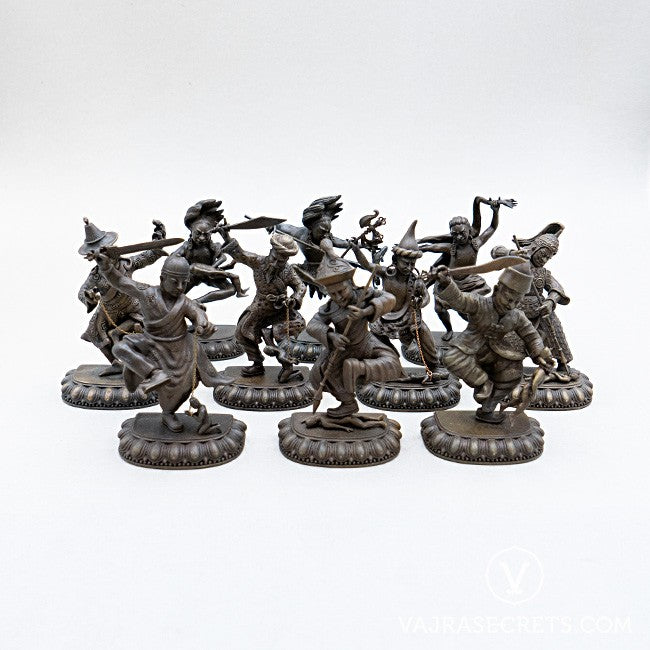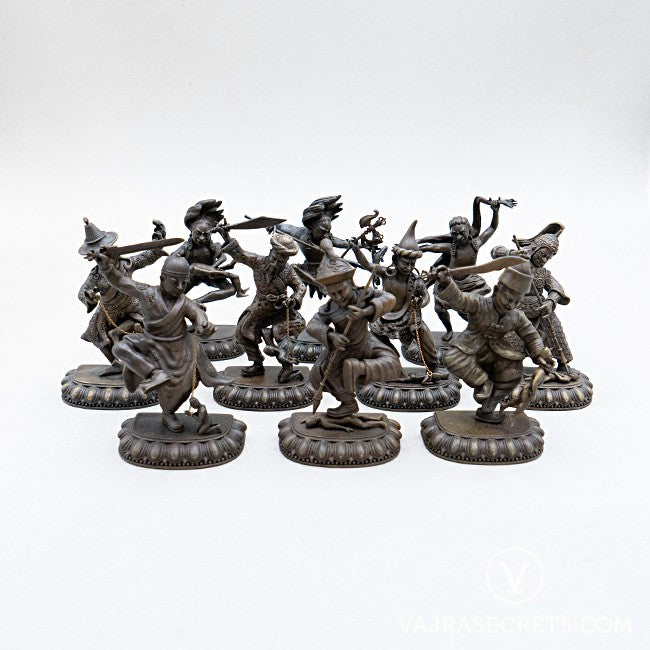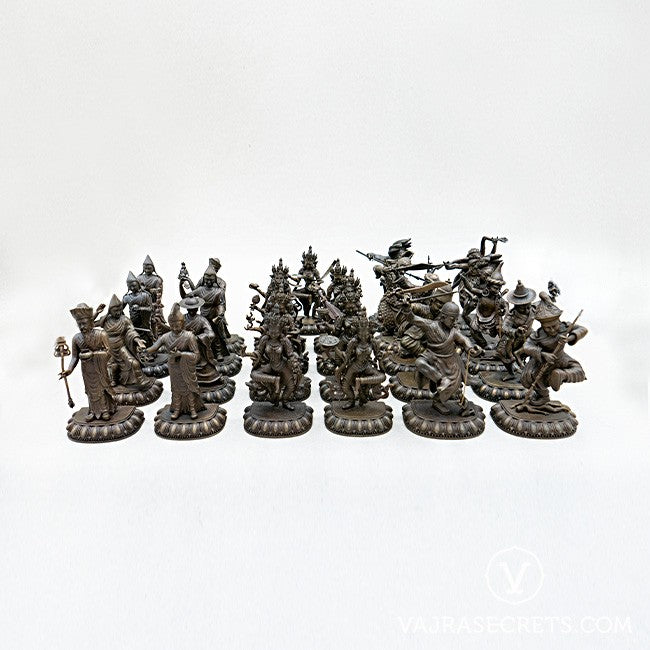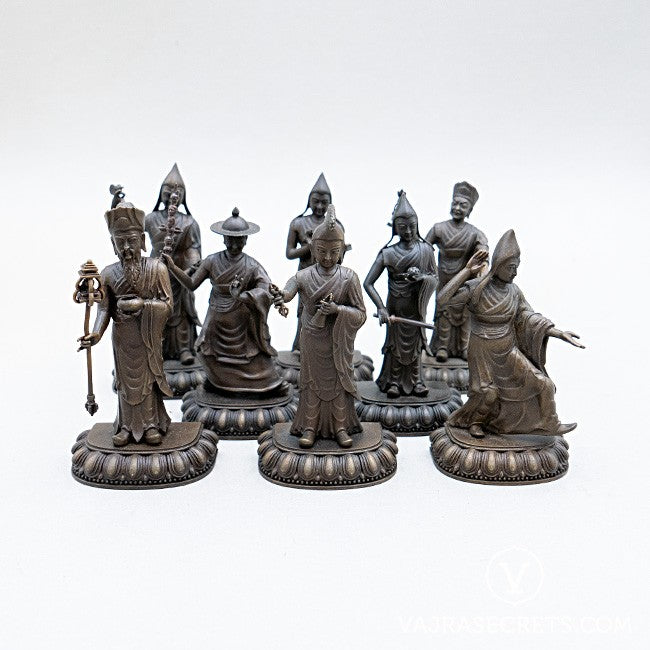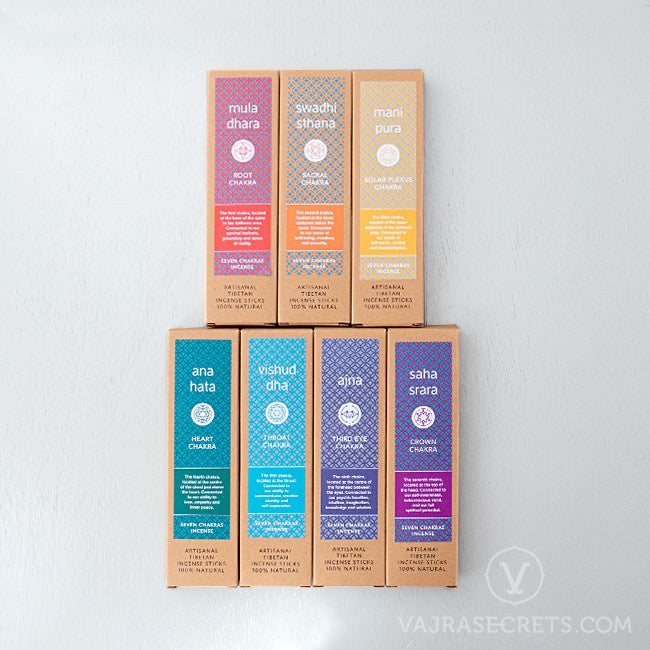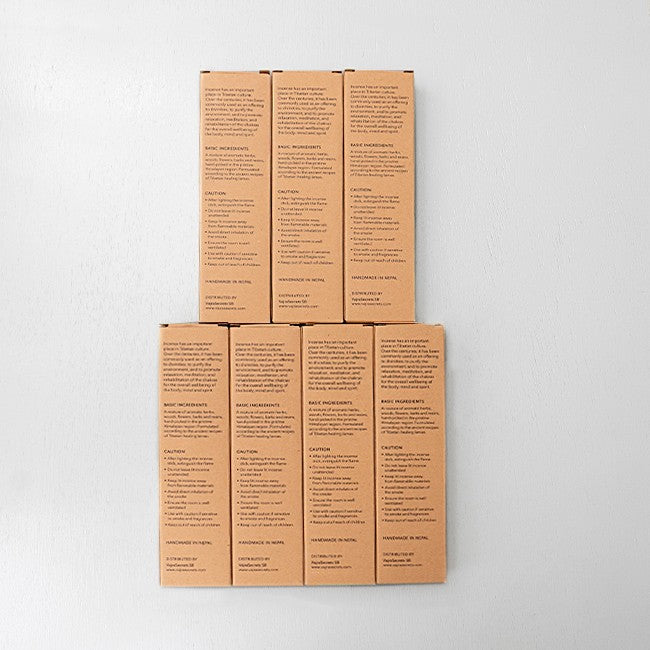A full set collection of Dorje Shugden's 27-deity retinue into your personal worship or meditation space. Offering representations of a deity's retinue is symbolic of your request for swift activity. Hence, placing these images of Dorje Shugden's entourage on your protector shrine creates the causes for Dorje Shugden to swiftly lend his assistance and answer your prayers.
The full set includes:
- Eight Guiding Monks Collection: Representing the Eight Great Bodhisattvas.
- Nine Great Mothers Collection: Representing the Goddesses of the Four Elements and Five Senses.
- Ten Wrathful Attendants Collection: Representing the Ten Wrathful Ones.
- Finely crafted from brass.
- Deity iconography according to Buddhist scriptural sources.
- Natural matte finish.
- Mantra insertion and other statue enhancement services available for greater blessings and merits.
- Available in gold finish.
WITH COMPLIMENTS (while stocks last)
Get a complimentary set of 7 herbal rilbus for every statue you invite.
* As each item is handfinished, minor variations in shape, colour and finishing may occur from piece to piece. These do not impact its spiritual function and benefits.
About Dorje Shugden’s Entourage
The members of Dorje Shugden’s entourage – the Eight Guiding Monks, the Nine Great Mothers and the Ten Youthful and Wrathful Attendants – are manifestations of his mind. Taking on various appearances and forms, they each perform a specific function in relation to your spiritual path in general and your practice of Dorje Shugden in particular.
The Eight Guiding Monks assist practitioners by removing obstacles and creating favourable conditions for the holding of vows and the growth of Dharma. In particular, they assist sincere disciples in the practice of Sutra.
The Nine Great Mothers are divinely beautiful celestial maidens who help practitioners develop control over the body’s four elements and five senses. In particular, they aid Tantric practitioners to gain attainments through higher levels of meditations.
The Ten Youthful and Wrathful Attendants help practitioners avert inner and outer obstacles. In particular, they assist sincere disciples in keeping their commitments to their spiritual guides.
Our quality representations are made in strict accordance to the iconography taught by H.E. Kyabje Dagom Rinpoche.
The full set includes:
- Gelong Jampa, representing Maitreya
- Gelong Sanggyin, representing Ksitigarbha
- Gelong Chagdor, representing Vajrapani
- Gelong Namnying, representing Akashagarbha
- Gelong Wangchuk, representing Avalokiteshvara
- Gelong Jamyang, representing Red Manjushri
- Gelong Dipsel, representing Sarvanivarana-Viskambhin
- Gelong Kunsang, representing Samantabhadra
- White Goddess of Earth, representing Lochana
- Blue Goddess of Water, representing Mamaki
- Red Goddess of Fire, representing Pandaravasini
- Green Goddess of Wind, representing Tara
- White Goddess of Form, representing Rupavajra
- Yellow Goddess of Sound, representing Shaptavajra
- Red Goddess of Scent, representing Gandhavajra
- Green Goddess of Taste, representing Rasavajra
- Blue Goddess of Sensations, representing Parshavajra
- Chinese Attendant, representing Yamantaka
- Mongolian Attendant, representing Hayagriva
- Nepali Attendant, representing Aparajita
- Tibetan Attendant, representing Vighnantaka
- Kashmiri Attendant, representing Achala
- Indian Acharya Attendant, representing Takkiraja
- Fanged Yama, representing Niladanda
- Powerful Yama, representing Mahabala
- Khorgyur Lha Trowo, representing Ushnishachakravarti
- Jadong Gyalpo, representing Sumbharaja
1. Gelong Jampa
The first of the Eight Guiding Monks, Gelong Jampa represents the Bodhisattva Maitreya, who is the embodiment of the Buddha's loving-kindness and the personification of his activities. He wears monk robes, a meditation hat and the special boots of high nobility. He holds a monk staff in his right hand and a begging bowl in his left. He has a moustache and beard, and abides amidst a gathering of rainbows and clouds. In Dorje Shugden's mandala, he is below the Nine Mothers and represents the veins of Lama Losang Tubwang Dorje Chang's body.
2. Gelong Sanggyin
The second of the Eight Guiding Monks, Gelong Sanggyin represents the Bodhisattva Ksitigarbha, the personification of the Buddha's merit who increases the richness and fertility of the land. He wears monk robes, a pointed monk's hat and stands in a dancing posture. He holds a vajra in his right hand, a bell in his left and abides amidst a gathering of rainbows and clouds. In Dorje Shugden's mandala, he is to the left of Gelong Jampa and represents the eye sense power of Lama Losang Tubwang Dorje Chang's body.
3. Gelong Chagdor
The third of the Eight Guiding Monks, Gelong Chagdor represents the Bodhisattva Vajrapani, the embodiment of the Buddha's spiritual power. He wears monk robes and a pandit's hat. He stands in a debating posture and abides amidst a gathering of rainbows and clouds. In Dorje Shugden's mandala, he is to the left of Gelong Sanggyin and represents the ear sense power of Lama Losang Tubwang Dorje Chang's body.
4. Gelong Namnying
The fourth of the Eight Guiding Monks, Gelong Namnying represents the Bodhisattva Akashagarbha, the personification of the Buddha's blessings who purifies transgressions perfectly. He wears monk robes and a golden Tang hat. He holds a khatangka in his right hand and points at his disciples with his index finger in a threatening mudra with his left hand. His right leg is bent and his left is extended and stepping on a geg spirit. He abides amidst a gathering of rainbows and clouds. In Dorje Shugden's mandala, he is to the left of Gelong Chagdor and represents the nose sense power of Lama Losang Tubwang Dorje Chang's body.
5. Gelong Wangchuk
The fifth of the Eight Guiding Monks, Gelong Wangchuk represents the Bodhisattva Avalokiteshvara, the personification of the Buddha's compassion. He wears monk robes, a pandit's hat and the special boots of high nobility. He holds a sword pointed downwards in his right hand and holds up a nectar-filled skullcup in his left. He appears to be moving quickly and abides amidst a gathering of rainbows and clouds. In Dorje Shugden's mandala, he is to the left of Gelong Namnying and represents the tongue sense power of Lama Losang Tubwang Dorje Chang's body.
6. Gelong Jamyang
The sixth of the Eight Guiding Monks, Gelong Jamyang represents the Bodhisattva Red Manjushri, the personification of the Buddha's wisdom. He wears monk robes and a Bodhisattva's hat. He plays a damaru with his right hand and rings a bell with his left. His legs are in a dancing position and he abides amidst a gathering of rainbows and clouds. In Dorje Shugden's mandala, he is to the left of Gelong Wangchuk and represents the mental power of Lama Losang Tubwang Dorje Chang's body.
7. Gelong Dipsel
The seventh of the Eight Guiding Monks, Gelong Dipsel represents the Bodhisattva Sarvanivarana-Viskambhin, the personification of the Buddha's qualities who purifies wrong-doings and overcomes obstacles. He wears monk robes, a pandit's hat and the special boots of high nobility. His right hand is in the mudra of teaching the Dharma at his heart and he holds up a scriptural text in his left. He appears to be moving quickly and abides amidst a gathering of rainbows and clouds. In Dorje Shugden's mandala, he is to the left of Gelong Jamyang and represents the body sense power of Lama Losang Tubwang Dorje Chang's body.
8. Gelong Kunsang
The last of the Eight Guiding Monks, Gelong Kunsang represents the Bodhisattva Samantabhadra, the personification of the Buddha's aspirations who displays special expertise in making offerings and prayers of aspiration. He wears monk robes, a meditation hat and the special boots of high nobility. He holds up a treasure vase in his right hand and points at his disciples with his index finger in a threatening mudra with his left hand. He appears to be moving to the right and abides amidst a gathering of rainbows and clouds. In Dorje Shugden's mandala, he is to the left of Gelong Dipsel and represents the joints of Lama Losang Tubwang Dorje Chang's body.
9. White Goddess of Earth
The first of the Nine Great Mothers, the White Goddess of Earth represents the Goddess Lochana, the consort of Akshobhya. Adorned with precious ornaments and celestial silken garments, she is white in colour and manifests as a charming youth of unsurpassable beauty in a dancing posture. In her right hand, she carries Mount Meru and in her left she holds a treasure vase. She carries a golden vajra axe in the crook of her left arm and abides amidst a gathering of rainbows and clouds. In Dorje Shugden's mandala, she appears midway between Shize and Trakze.
10. Blue Goddess of Water
The second of the Nine Great Mothers, the Blue Goddess of Water represents the Goddess Mamaki, the consort of Ratnasambhava. Adorned with precious ornaments and celestial silken garments, she is light blue in colour and manifests as a charming youth of unsurpassable beauty in a dancing posture. In her right hand, she hold a precious vase overflowing with nectar and in her left she holds a treasure vase. She carries a golden vajra axe in the crook of her left arm and abides amidst a gathering of rainbows and clouds. In Dorje Shugden's mandala, she appears to the left of the Goddess of Earth.
11. Red Goddess of Fire
The third of the Nine Great Mothers, the Red Goddess of Fire represents the Goddess Pandaravasini, the consort of Amitabha. Adorned with precious ornaments and celestial silken garments, she is red in colour and manifests as a charming youth of unsurpassable beauty in a dancing posture. In her right hand, she holds aloft a burning flame with a wrathful mudra and in her left she holds a treasure vase. She carries a golden vajra axe in the crook of her left arm and abides amidst a gathering of rainbows and clouds. In Dorje Shugden's mandala, she appears to the left of the Goddess of Water.
12. Green Goddess of Wind
The fourth of the Nine Great Mothers, the Green Goddess of Wind represents the Goddess Tara, the consort of Amoghasiddhi. Adorned with precious ornaments and celestial silken garments, she is green in colour and manifests as a charming youth of unsurpassable beauty in a dancing posture. Her right hand is in a wrathful mudra, creating wind, and in her left she holds aloft a treasure vase. She carries a golden vajra axe in the crook of her left arm and abides amidst a gathering of rainbows and clouds. In Dorje Shugden's mandala, she appears to the left of the Goddess of Fire.
13. White Goddess of Form
The fifth of the Nine Great Mothers, the White Goddess of Form is also known as Rupavajra, the offering goddess representing the emptiness of visible objects. Adorned with precious ornaments and celestial silken garments, she is white in colour and manifests as a charming youth of unsurpassable beauty in a dancing posture. She holds a mirror in her right hand and a treasure vase in her left. She carries a golden vajra axe in the crook of her left arm and abides amidst a gathering of rainbows and clouds. In Dorje Shugden's mandala, she appears two levels below Shize.
14. Yellow Goddess of Sound
The sixth of the Nine Great Mothers, the Yellow Goddess of Sound is also known as Shaptavajra, the offering goddess representing the emptiness of sound. Adorned with precious ornaments and celestial silken garments, she is yellow in colour and manifests as a charming youth of unsurpassable beauty in a dancing posture. She holds a vina in her right hand and a treasure vase in her left. She carries a golden vajra axe in the crook of her left arm and abides amidst a gathering of rainbows and clouds. In Dorje Shugden's mandala, she appears slightly below and to the left of the Goddess of Form.
15. Red Goddess of Scent
The seventh of the Nine Great Mothers, the Red Goddess of Scent is also known as Gandhavajra, the offering goddess representing the emptiness of smell. Adorned with precious ornaments and celestial silken garments, she is red in colour and manifests as a charming youth of unsurpassable beauty in a dancing posture. She holds a conch shell filled with perfume in her right hand and a treasure vase in her left. She carries a golden vajra axe in the crook of her left arm and abides amidst a gathering of rainbows and clouds. In Dorje Shugden's mandala, she appears slightly below and to the left of the Goddess of Sound.
16. Green Goddess of Taste
The eighth of the Nine Great Mothers, the Green Goddess of Taste is also known as Rasavajra, the offering goddess representing the emptiness of taste. Adorned with precious ornaments and celestial silken garments, she is green in colour and manifests as a charming youth of unsurpassable beauty in a dancing posture. She holds a vessel filled with exquisite delicacies in her right hand and a treasure vase in her left. She carries a golden vajra axe in the crook of her left arm and abides amidst a gathering of rainbows and clouds. In Dorje Shugden's mandala, she appears slightly above and to the left of the Goddess of Scent.
17. Blue Goddess of Sensations
The last of the Nine Great Mothers, the Blue Goddess of Sensations is also known as Parshavajra, the offering goddess representing the emptiness of tangible objects. Adorned with precious ornaments and celestial silken garments, she is blue in colour and manifests as a charming youth of unsurpassable beauty in a dancing posture. She holds a delicate blue garment in her right hand and a treasure vase in her left. She carries a golden vajra axe in the crook of her left arm and abides amidst a gathering of rainbows and clouds. In Dorje Shugden's mandala, she appears slightly above and to the left of the Goddess of Taste.
18. Chinese Attendant
The first of the Ten Wrathful Attendants, the Chinese Attendant represents Yamantaka. He appears as a Chinese youth wearing traditional Chinese attire. He holds aloft a sword in his right hand with a wrathful mudra. His right leg is bent upwards and his left leg extends backwards. In front of him, a man bows down in homage. He abides in the midst of gathered fire and wind. In Dorje Shugden's mandala, he is below and to the right of the Eight Guiding Monks and represents the right hand of Lama Losang Tubwang Dorje Chang.
19. Mongolian Attendant
The second of the Ten Wrathful Attendants, the Mongolian Attendant represents Hayagriva. He appears as a Mongolian youth wearing traditional Mongol attire and holds a downturned spear with both hands. His right leg is extended, crushing a vow-breaker who is face down and his left leg is bent upwards. He abides in the midst of gathered fire and wind. In Dorje Shugden's mandala, he is to the left of the Chinese Attendant and represents the mouth of Lama Losang Tubwang Dorje Chang.
20. Nepali Attendant
The third of the Ten Wrathful Attendants, the Nepali Attendant represents Aparajita. He appears as a Nepali youth wearing traditional Nepali attire. He holds a traditional Nepali knife (khukri) with his right hand and holds on to the neck of a vow breaker with his left. He abides in the midst of gathered fire and wind. In Dorje Shugden's mandala, he is to the left of the Mongolian Attendant and represents the left hand of Lama Losang Tubwang Dorje Chang.
21. Tibetan Attendant
The fourth of the Ten Wrathful Attendants, the Tibetan Attendant represents Vighnantaka. He appears as a Tibetan youth wearing a traditional Tibetan nomad's chuba and hat, and he is barefoot. In his right hand he holds a noose by which he holds on to a vow-breaker and in his left hand he holds a drigug (flaying knife) brandished skywards. He appears to be moving to the left and abides in the midst of gathered fire and wind. In Dorje Shugden's mandala, he is to the left of the Nepali Attendant and represents the secret place of Lama Losang Tubwang Dorje Chang.
22. Kashmiri Attendant
The fifth of the Ten Wrathful Attendants, the Kashmiri Attendant represents Achala. He appears as a bearded and moustached Kashmiri youth wearing traditional Kashmiri attire. He holds up a long knife in his right hand and with his left, he binds both arms of a vow-breaker at the back with a long noose. His right leg is extended and his left is in a dancing posture. He abides in the midst of gathered fire and wind. In Dorje Shugden's mandala, he is to the left of the Tibetan Attendant and represents the right shoulder of Lama Losang Tubwang Dorje Chang.
23. Indian Acharya Attendant
The sixth of the Ten Wrathful Attendants, the Indian Acharya Attendant represents Takkiraja. He appears as an Indian youth wearing the traditional attire of an Indian acharya. He holds aloft a vajra axe in his right hand and a black noose in his left, tied to the neck of a vow-breaker. He appears to be moving to the left and abides in the midst of gathered fire and wind. In Dorje Shugden's mandala, he is to the left of the Kashmiri Attendant and represents the left shoulder of Lama Losang Tubwang Dorje Chang.
24. Fanged Yama
The seventh of the Ten Wrathful Attendants, Fanged Yama represents Niladanda. He wears a helmet and full armour and holds a lance with both hands piercing a vow-breaker's heart. His right leg is bent and his left is extended. He abides in the midst of gathered fire and wind. In Dorje Shugden's mandala, he is to the left of the Indian Acharya Attendant and represents the right knee of Lama Losang Tubwang Dorje Chang.
25. Powerful Yama
The eighth of the Ten Wrathful Attendants, Powerful Yama represents Mahabala. His right hand holds a vow-breaker on his lap and his left hand is in the vow-breaker's stomach. Wrathful in appearance, he is jumping with both legs spread wide and abides in the midst of gathered fire and wind. In Dorje Shugden's mandala, he is to the left of Fanged Yama and represents the left knee of Lama Losang Tubwang Dorje Chang.
26. Khorgyur Lha Trowo
The ninth of the Ten Wrathful Attendants, Khorgyur Lha Trowo represents Ushnishachakravarti. He holds a vow-breaker upside down with his left hand and with his right, he pierces the vow-breaker's heart with a lance. He is jumping with both legs spread wide and abides in the midst of gathered fire and wind. In Dorje Shugden's mandala, he is to the left of Powerful Yama and represents the crown of Lama Losang Tubwang Dorje Chang.
27. Jadong Gyalpo
The last of the Ten Wrathful Attendants, Jadong Gyalpo represents Sumbharaja. He wears a human skin on his back and both hands are stretched upwards in a wrathful mudra. He is jumping with his right leg crossed to the left and his left leg is extended backwards. He abides in the midst of gathered fire and wind. In Dorje Shugden's mandala, he is to the left of Khorgyur Lha Trowo and represents the soles of Lama Losang Tubwang Dorje Chang.
Further Reading
- Dorje Shugden Mandala
- The Entourage of the King Dorje Shugden
- Beginner's Introduction to Dorje Shugden
- Dorje Shugden Shize: A practice for healing and long life
- Dorje Shugden Gyenze to Increase Life, Merits and Wealth
- Dorje Shugden Wangze for Power and Influence
- Dorje Shugden Trakze to Dispel Black Magic & Spirits
- Tsem Rinpoche Guiding the Simplified Sadhana (Daily Prayers) of Dorje Shugden
- Material: Brass
- Height: Approx. 100 mm (3.9-in)
- Width: Approx. 60 mm (2.4-in)
- Total weight: Approx. 3.5 kg (7.7 lb)









